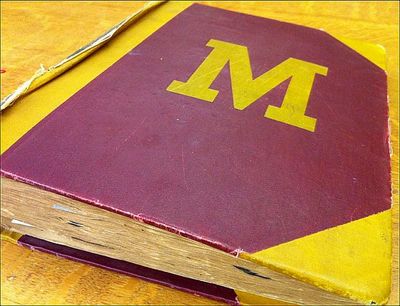 The teaching of geology often starts with an introduction to the geologic time scale as a means to acquaint students with the concept of deep time and how to better comprehend eons, eras & epochs.
The teaching of geology often starts with an introduction to the geologic time scale as a means to acquaint students with the concept of deep time and how to better comprehend eons, eras & epochs.
Although littered with catastrophic events such as meteorite impacts, volcanic eruptions, and earthquakes, the surface of the earth and the life forms it has supported have been most profoundly changed by the incremental affects of water, plate tectonics, and photosynthesis over the course of 4.5 billion years.
So, do archives have a deep time?
Occasionally, the events that bring records to the archives are cataclysmic: the death of an individual, the closing of an organization, or even a natural disaster. These same catastrophes all too frequently tilt toward the utter destruction of the materials and remove them entirely from the record.
But more commonly, records trickle in like water, move slowly from one place to another, and even proliferate through technological photogenic processes such as the photocopier and scanner.
These deep time thoughts, so to speak, came to me last week as I looked over a recently acquired collection of correspondence. The letters are to and from Hal Downey (1877-1959), a world-renowned hematologist who spent the majority of his life studying, teaching, and researching at the University of Minnesota.
The collection is largely exchanges between Downey and his colleagues in the U.S. and Europe before World War I through the late 1950s. Most notable are a series of letters related to Dr. A. Maximov, a Russian hematologist looking to escape the restrictive conditions of early Soviet Russia. Downey eventually helped Maximov secure a position at the University of Chicago.
However, it was actually a pair of letters that set my thoughts in motion. The first was a letter from E. W. McDiarmid the University Librarian dated February 26, 1946 on the occasion of Downey’s retirement. In his letter McDiarmid requested that Downey consider turning over to the archives any material he will no longer need in his retirement. He specifically asked for letters, committee reports, and departmental correspondence that may be in his possession.
Downey responded that “it is not likely that I have anything of importance” and that he hoped to remain in his lab space for years to come. He would remember the archives if anything seemed of value.
Sixty-three years later, Hal Downey’s daughter and two granddaughters deposited his valuable correspondence in the archives. The material joined a small collection of Downey’s manuscripts that were donated by his wife Iva shortly after his death in 1959. It was a lifetime between McDiarmid’s request and the actual deposit. It was a fraction of the University’s history. It was a blip on the geologic time scale.
If we are students of the earth then we realize that none of us are permanent residents of this planet, nor are our institutions. Yet, to invoke Hutton, archives exist because we see “no vestige of a beginning, no prospect of an end.” So, we create, document, preserve, and then begin again.
Read the letters between McDiarmid and Downey below.
Image Credit: A diagram of the geological time scale available from the US Geologic Survey. Source image available from the Wikimedia Commons.





 If the
If the  Archives are often described as organic in nature and the material within the collections as containing organic-like relationships that archivists strive to preserve and to promote.
Archives are often described as organic in nature and the material within the collections as containing organic-like relationships that archivists strive to preserve and to promote.
 The University of Minnesota has long been a leader in medical advances and technologies. Since the 1960s, the University has been synonymous with advances in transplant procedures. Prior to that, the medical school gave rise to corrective open heart procedures. Two of the men that were involved with this earlier era were C. Walton Lillehei and Richard Varco.
The University of Minnesota has long been a leader in medical advances and technologies. Since the 1960s, the University has been synonymous with advances in transplant procedures. Prior to that, the medical school gave rise to corrective open heart procedures. Two of the men that were involved with this earlier era were C. Walton Lillehei and Richard Varco.